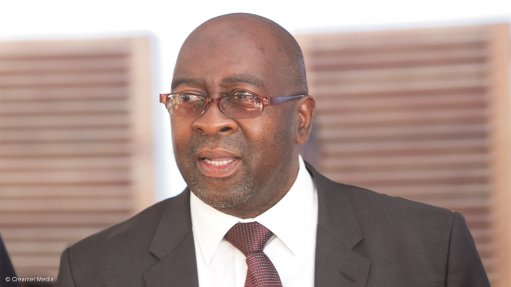
Finance Minister Nhlanhla Nene
Photo by: Duane Daws
Finance Minister Nhlanhla Nene reported on Monday that nonstrategic government assets had been identified within various government departments that could be used to support an equity injection into the financially strained State-owned electricity producer, Eskom. The Minister refused to disclose the nature of the assets, nor the size of the eventual financial injection.
Nene was responding to questions posed to him by Engineering News Online in Midrand, where he was participating in an annual results briefing held by the Development Bank of Southern Africa.
A day earlier, the National Treasury confirmed in a statement that Cabinet had approved a multi-dimensional support package for Eskom, which included a further allocation of funds.
The statement said that the “equity injection” would be funded through “leveraging nonstrategic government assets”.
The equity injection was seen as a way of helping to relieve the impact on electricity consumers of possible higher tariffs, which government said remained “the key mechanism that will provide the electricity supply industry with a sustainable solution”.
Nene indicated that details of the equity injection would be released as part of the Medium-Term Budget Policy Statement, which is due for release on October 22.
No mention was made in the plan by Nene of any disposal of Eskom power-station assets, as speculated at one point. “I wouldn’t want to pre-empt what we are going to do . . . but I’m not too sure that we can regard a power station as a nonstrategic asset,” he said.
He added that assets, which were “located within various departments in government”, had been identified and that there was “an ongoing engagement” on the assets in question.
“If you look at the package that we have put together as government for Eskom, we mention a number of things, one of which is the disposal on nonstrategic assets,” Nene also stressed.
In a statement released by the National Treasury on Sunday afternoon, it was indicated that government would also support Eskom’s application to the National Energy Regulator of South Africa (Nersa) for “tariff adjustments in line with the regulatory process”.
The utility had already applied for, and partially received, claw-back relief from Nersa under the Regulatory Clearing Account (RCA) mechanism for the second multiyear price determination period (MYPD2), which covered the three-year time horizon from April 1, 2010, to March 31, 2013.
While the distribution mechanism had not yet been finalised, the decision was expected to begin impacting tariffs from April 1, 2015, over and above the 8% already sanctioned. Eskom was expected to begin making MYPD3 RCA applications in due course.
However, the Cabinet plan might also clear the way for a tariff “reopener”, whereby Eskom might again seek the 16% a year increases it had requested for the five-year period from April 1, 2013, to March 31, 2018.
Tariff adjustments, the National Treasury argued, should provide Eskom with the revenue and cash flows required to complete the current programme of building power stations, while enabling it to repay debt and interest. “Nersa will still apply its regulatory oversight, and prudency tests to ensure that costs across the industry have been efficiently incurred,” the statement added.
Besides its support for tariffs adjustments and the equity injection, Cabinet approved the following other components of a plan designed to help close what Eskom has calculated to be a R225-billion revenue shortfall:
- A plan to support Eskom in raising additional debt of about of R50-billion, over and above its original plan of R200-billion during the MYPD3 period. “While higher debt levels do have a negative impact on Eskom’s balance sheet, it is necessary to reduce the immediate impact on electricity consumers. Raising more debt is supported by the substantial guarantee facility available to Eskom from government, which will be used to reduce Eskom’s cost of debt, but also needs to be supported by a sustainable industry, relying on managing costs and raising sufficient revenue to cover these.”
- An acceleration of demand management measures that do not undermine economic growth.
- A refinement of energy policy and regulatory governance mechanisms to help keep the lights on and give certainty regarding the energy industry going forward.
- Interventions to ensure that free basic electricity allocations are used effectively to cushion poor households from the impact of higher tariffs. Government would assist municipalities address the current weaknesses in the use of free basic electricity allocations. In addition, government will implement a programme to improve the efficiency of municipal electricity operations.
- Support for the expansion of the Independent Power Producer programme to complement Eskom's build programme.
- And an insistance on savings and efficiencies at Eskom. “As a result, Eskom will need to improve the efficiency of its operations through more effective maintenance of existing power stations, limiting cost overruns in the new build programme, improving procurement outcomes and management of working capital.”
The package was approved at a special Cabinet meeting in Cape Town on Thursday and was based on recommendations from an Inter-Ministerial Committee, whose work was said to be ongoing and would “include wide consultation to ensure that the best possible solutions are considered to ensure energy security going forward”.
Eskom said it was premature for it to comment and that it would only do so once “we have studied the details of the package approved”.
The timing of the package coincides with scheduled updates by a number of credit rations agencies, which have already downgraded Eskom and had cautioned that the outlook remained negative.
Much attention would now be given to the actual size of the equity injection, which would be additional to a R60-billion subordinated loan already advanced and government guarantees of R350-billion. There would also be much interest in what “leveraging nonstrategic government assets” implied and which State companies and/or agencies might be affected.